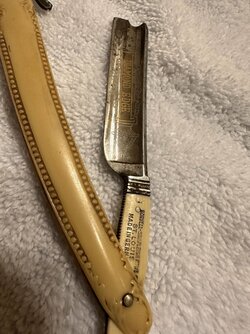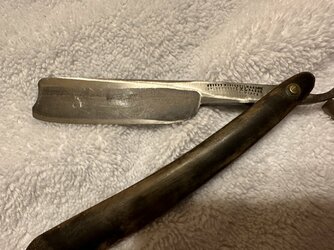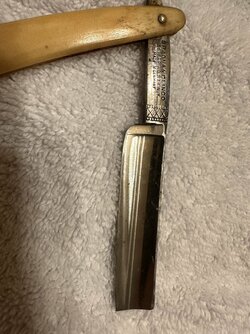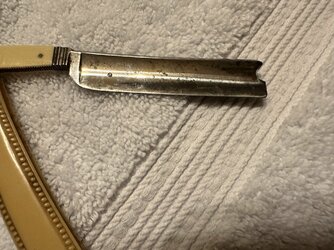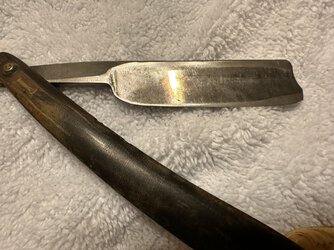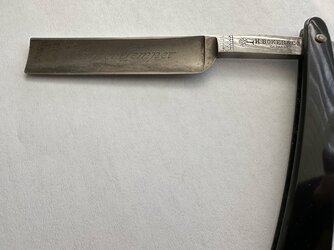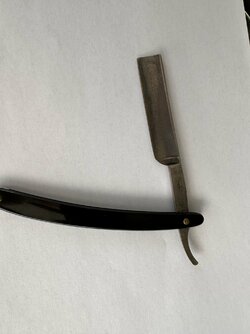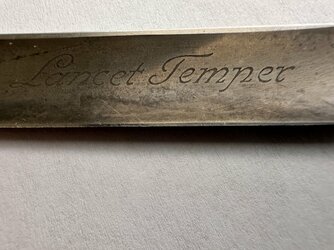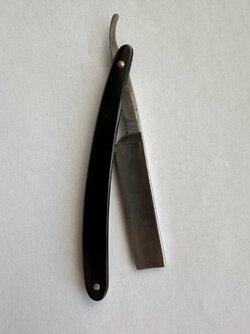You are using an out of date browser. It may not display this or other websites correctly.
You should upgrade or use an alternative browser.
You should upgrade or use an alternative browser.
Advice on what’s worth sending out
- Thread starter swiftliketaylor13
- Start date
- Thread starter
- #2
If your question is which ones would be the nicest restored or worth paying someone to rejuvenate then I would probably select the Boker and old Sheffield. The other two look like they can be restored as well though to some extent. Keep in mind, depending on how restored you want them, any regrind or blade polishing will remove any gold wash and possibly blade etching.
Worth sending out? Probably none of them are worth sending out.
All would be great to learn to do it yourself.
After you’ve cleaned them up, you can send them out for honing if needed.
All would be great to learn to do it yourself.
After you’ve cleaned them up, you can send them out for honing if needed.
Yup, as said in this and other post, buy razors in the “best” condition, there are millions of vintage razors in the wild, millions…
The Boker and Anchor are the best of the four, because of condition, least amount of spine wear and rust. Though they will need a good cleaning prior to honing. They all need a good, heavy cleaning. Do not strop any of these razors or you will contaminate your strops with the rust and muck, and you will never get it out of your strops.
Send them out for restoration? Not worth the money unless they have sentimental value.
The Norvell is pretty rough, heavy rust and you will loose the Gold and etch to properly restore the blade, and not a fan of covered tangs, they are thick and clunky to strop, and you will be stropping daily. You can only imagine the rust under the covered tang.
The scales are cool, but don’t get sucked in by pretty scales unless you are buying the razor for the scales. I have bought many razors just for the scales or even just the bolsters, but I am paying a Dollar or two.
The Wolstenholme’s better days have long passed, was sorely mistreated and trashed on aggressive hones. Notice the hone wear on the tang, all the way to the pivot pin. Needlessly trashed.
It can be made to shave but will require honing with tape, lots of tape to get a good edge.
The Anchor and Boker are the best razors to learn to hone on, just tape the spine when learning so you don’t end up with another Wostenholm.
All can be made to shave, in skilled hands, none are exceptionally valuable or collectable.
You can post photo on this and other fora, for opinions prior to purchase or send photos to members for advice, and valuation, prior to purchase.
The Boker and Anchor are the best of the four, because of condition, least amount of spine wear and rust. Though they will need a good cleaning prior to honing. They all need a good, heavy cleaning. Do not strop any of these razors or you will contaminate your strops with the rust and muck, and you will never get it out of your strops.
Send them out for restoration? Not worth the money unless they have sentimental value.
The Norvell is pretty rough, heavy rust and you will loose the Gold and etch to properly restore the blade, and not a fan of covered tangs, they are thick and clunky to strop, and you will be stropping daily. You can only imagine the rust under the covered tang.
The scales are cool, but don’t get sucked in by pretty scales unless you are buying the razor for the scales. I have bought many razors just for the scales or even just the bolsters, but I am paying a Dollar or two.
The Wolstenholme’s better days have long passed, was sorely mistreated and trashed on aggressive hones. Notice the hone wear on the tang, all the way to the pivot pin. Needlessly trashed.
It can be made to shave but will require honing with tape, lots of tape to get a good edge.
The Anchor and Boker are the best razors to learn to hone on, just tape the spine when learning so you don’t end up with another Wostenholm.
All can be made to shave, in skilled hands, none are exceptionally valuable or collectable.
You can post photo on this and other fora, for opinions prior to purchase or send photos to members for advice, and valuation, prior to purchase.
I kind of like the challenge of taking on an ambitious restore, a razor that may have been passed over as too much work. But I tend to stick too razors that somehow really pic my interest. Then I go all OCD on them. A life time of metal working has left me with many transferable skills and I use them all and, I have learned new ones here. You could never pay for the time I put into a razor restore unless you were Bill gates or George Soros etc. By doing it yourself....you are owning it...making it yours.....showing your skills and patience. If, you are inclined to do it yourself, and can pull it off, do so. I trust me to do a restore, and I know I can afford it.
Nice scores by the way, the Boker looks like it would turn out to be a nice piece!
Nice scores by the way, the Boker looks like it would turn out to be a nice piece!
- Thread starter
- #7
Thank you for your replies and advice.
My post was to see if they’re salvageable in the hands of a professional.
I’m a collector so far. I was hoping that I’d hear “oh yea those are all very easy to restore and / or repair”
I know a lot about DE, SE, adjustables, etc. What to look for, what to avoid, and more.
I need to learn more about straight razors. Especially the blades before I buy one again.
I truly appreciate the advice and thank you for helping me learn a bit more
My post was to see if they’re salvageable in the hands of a professional.
I’m a collector so far. I was hoping that I’d hear “oh yea those are all very easy to restore and / or repair”
I know a lot about DE, SE, adjustables, etc. What to look for, what to avoid, and more.
I need to learn more about straight razors. Especially the blades before I buy one again.
I truly appreciate the advice and thank you for helping me learn a bit more
My suggestions for shopping for old razors to restore is this:
No chips, no hone wear to speak of, no rust, no cracks, not warped. Normal honing is fine, avoid anything really well used. Lots of unused razors out there. Really used hard razors can usually be made to shave, but it's a lot of work and it's cheaper and easier to find a better example.
Scales can be replaced, and should be if they are celluloid showing any signs of degredation. Razors showing corrosion where the scales cover them are a no- go, the nitric acid released by the decomposing celluloid will pit them beyond repair very quickly.
Prices are all over the place, with desirable ones like Dubl-Duck or Dovo being quite expensive for perfect ones to a few dollars for a perfectly good hardware store branded Solingen or Sheffield razor.
No chips, no hone wear to speak of, no rust, no cracks, not warped. Normal honing is fine, avoid anything really well used. Lots of unused razors out there. Really used hard razors can usually be made to shave, but it's a lot of work and it's cheaper and easier to find a better example.
Scales can be replaced, and should be if they are celluloid showing any signs of degredation. Razors showing corrosion where the scales cover them are a no- go, the nitric acid released by the decomposing celluloid will pit them beyond repair very quickly.
Prices are all over the place, with desirable ones like Dubl-Duck or Dovo being quite expensive for perfect ones to a few dollars for a perfectly good hardware store branded Solingen or Sheffield razor.
Similar threads
- Replies
- 29
- Views
- 911
- Replies
- 15
- Views
- 899
- Replies
- 1
- Views
- 149
